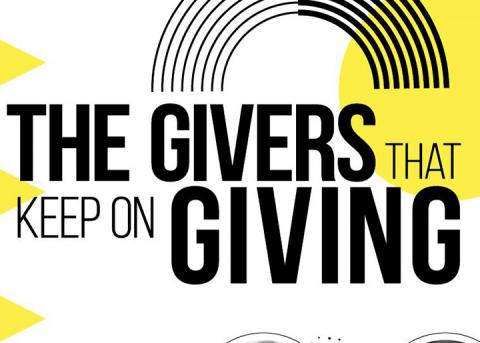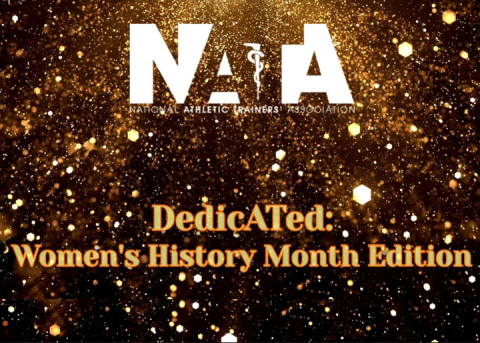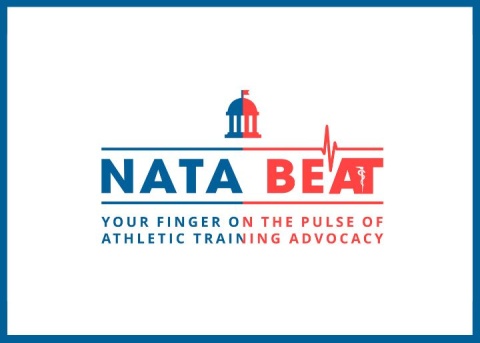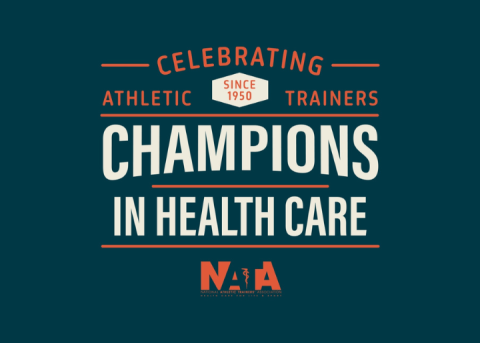
By Kim Diggs
In honor of National Volunteer Month this April, we’re zooming in on the moments that have moved NATA members most since becoming active in their prospective committees and discovering what gaps these volunteer initiatives bridge. This is an extension of the Q&A found in the April NATA News. When you’re done reading, you can learn more about NATA’s volunteer opportunities.
Sara Bjerke, MS, LAT, ATC
State Association Advisory Committee
North Dakota, District Five
What’s one of your favorite moments when you saw the work of your committee make an impact on someone?
At the State Leadership Forum, we have 100 state leaders from across the country gathered to learn from each other. Seeing a group of leaders from different parts of the country who have never met before that day collaborating and exchanging information has been awesome to watch, especially when the next year, state leaders return with success stories of taking the knowledge gained from SLF and sharing what has been accomplished in their state.
What personal connection do you have with the people this committee serves and did that affect your decision to volunteer?
I did not have a personal connection with anyone on the committee when I started. My decision to volunteer was just to try to give back a little to athletic training some of what athletic training has given to me. But now, after serving with these awesome people, the connections I have made will last forever. There is nothing like being in a room with a group of people of vastly different backgrounds, all working to achieve the same goal of moving forward and leaving it better than when you started. I have made some friendships that will last a life time.
What void do you think your committee is filling within sports medicine?
We are helping grow state leaders. At the grassroots level, our task is to give state leaders the tools and resources to be the best advocates and leaders for athletic training that they can be. We are connecting new leaders with experienced leaders to be able to grow new skills from each other. We are connecting states that are in different regions of the country to be able to learn from each other’s successes and mistakes. We connect NATA to state associations to ensure that no state feels like they are isolated with no one to turn to for guidance.
Mark Cairns, ATC, PRT
ATs Care Committee
Kansas, District Five
What personal connection do you have with the people this committee serves and did that affect your decision to volunteer?
ATs Care helps both student athletic trainers and athletic trainers get through the aftermath of a critical incident. Throughout my career, I have placed people on backboards after spine injuries that leave them impaired. I have also provided care to people suffering cardiac arrest who were later pronounced dead. I knew this profession could do better in helping its members with the aftermath from when something like this happens. Then, ATs Care was formed. I’m lucky to have been given this opportunity to serve my fellow athletic trainers when they ask for help after going through a critical incident.
What’s one of your favorite moments when you saw the work of your committee make an impact on someone?
Since every conversation I have with an athletic trainer dealing with a critical incident is confidential, I cannot go into too much detail. One athletic trainer did mention that he was about to end his career in athletic training due to a patient dying on the field several months earlier. He also said his marriage of over many years was going downhill since the critical incident. After time spent with me in an intervention and giving him an action plan to use after the intervention, he is still in the profession and still married to his wonderful wife.
What void do you think your committee is filling within sports medicine?
Over my three-plus decades of being in this profession, nothing like ATs Care has been present. ATs Care provides peer-to-peer support when something out of the ordinary happens such as an athletic trainer providing CPR to a football player, putting someone on a backboard that is paralyzed, hearing that a patient committed suicide or hearing that a patient died in a car accident or was murdered. Now, we can contact someone who knows what it is like being an athletic trainer and can relate to the relationships we all have with our patients, coaches and staffs. The committee members are trained in how to provide care to a peer in their time of need. We, as athletic trainers, are so concerned about the health and wellbeing of others, but this committee is concerned about the health and wellbeing of athletic trainers.
Kysha Harriell, PhD, LAT, ATC
Ethnic Diversity Advisory Committee, Chair
Florida, District Nine
What void do you think your committee is filling within sports medicine?
I think the most significant void Ethnic Diversity Advisory Committee serves is being an advocate and resource for issues related to ethnically diverse patients and related health conditions and disparities that are more prevalent in different populations. Also, we have led the profession in educational and advocacy initiatives related to cultural competence and patient values.
For example, our collaboration with the Be The Match National Donor Marrow program has led to serve our members being a match for an ethnically diverse patient, whose chances of finding a match can range from approximately 23 percent to 57 percent, compared to white patients at 77 percent. Every time I see a post on social media that an AT was a match to a patient in need, it gives me chills and lets me know that EDAC's efforts are making a difference.
EDAC also serves as an advocate and as a resource for many members. The existence of the committee alone provides a platform to cultivate ethnically diverse leaders, as evident by the ethnically diverse Hall of Fame members, board of director members and numerous committee chairs and district representatives who have previously served on EDAC.
What personal connection do you have with the people this committee served and did that affect your decision to volunteer?
EDAC serves the needs of ethnically diverse athletic trainers and ethnically diverse patient populations. As an African-American, I had a very personal connection to the mission and goals of EDAC, which is why I decided to volunteer.
My connection to EDAC started when I was an undergraduate student. I had never met another ethnically diverse athletic trainers, and definitely not another African-American athletic trainer. In my senior year, I attended my first NATA conference where I was walking the conference halls and spotted another African-American woman; she stopped, greeted me and told me about the EDAC Town Hall meeting. That was a game changer; there were others like me and a whole room full of people who were helpful and willing to mentor me. I had great mentors at my school during my undergrad experience, but to also have mentors that looked like me was extra special. It made me a better student, and a more dedicated and confident student.
A few years later, I served as the EDAC graduate representative; then, I served as an EDAC council member (before we were a committee). Later, I came back to serve as a district representative, and, now, I am the chair. So, it's safe to say that the connection started in 1996 and it has been growing stronger ever since – or, in other words, EDAC can't seem to get rid of me.
What’s one of your favorite moments when you saw the work of your committee make an impact on someone?
Some of my favorite moments, by far, always occur during our EDAC service events. In the early morning of committee day during the NATA convention, we collaborate with a community center or organization in the host city. The past few years, we have hosted a health/career fair where we talk about the athletic training profession and/or health issues affecting ethnically diverse populations. During these events, I see in the eyes of the kids the same thing I felt at my first NATA convention – a look of “wow, they work with superstars; they are athletic trainers, doctors and professors … and they look like me!”
By the end of the event, I always find a group of kids that want to attend the "U," and we take a picture with the University of Miami hand signal. More importantly, now they know they can, and not just play sports, but study anything they want and I'll be there waiting for them. This year, we partnered with At Your Own Risk and the New Orleans Saints. With more than 75 EDAC volunteers participating, I believe the impact and visual was even greater. It was a great start to the convention, reminding us of the importance of what we do.
However, if I can only pick a single moment, it is definitely seeing the first African-American woman, René Revis Shingles, PhD, ATC, inducted into the Hall of Fame. It was her work as an EDAC chair and the work of all past and present EDAC members that helped to make our profession more diverse. It was a significant moment that I'm sure will inspire others.
Michael Hooper MA, ATC, LAT, CSCS
Committee on Practice Advancement, Armed Forces Committee, Chair
Virginia, District Three
What’s one of your favorite moments when you saw the work of your committee make an impact on someone?
Even though ATs have been in the armed forces setting for more than 20 years, we are still relatively unknown to many within military leadership. In the past five years or so, that relative obscurity has changed significantly. Several studies have been performed to show the effectiveness of incorporating the athletic training profession within the medical model, the significant return on investment and the decline in attrition, to name a few. New policies and regulations have also been developed to provide a complementary work environment to allow ATs to showcase their skills and worth in the model. Fifteen years ago, there was about 50 ATs in the setting; now, we have more than 300 with significant growth projected in the near future. I know this is not a single instance of impact on someone, but rather an impact on our setting.
What personal connection do you have with the people this committee serves and did that affect your decision to volunteer?
I have a personal connection with all of the athletic trainers in this profession. Regardless of the setting, level of experience or geographical location – each of us has a passion to do the best job we can do and to provide the highest level of care to those under our “protection”. This very passion for the profession gave me the motivation to volunteer for COPA. I personally felt that it was my responsibility to give back to the community and profession, to utilize my experience and influence to improve upon the Armed Forces setting and make it a more desirable employment opportunity.
What void do you think your committee is filling within sports medicine?
Education and awareness. As previously mentioned, ATs have been in the Armed Forces setting for more than 20 years, but just recently have gained acknowledgement as a valuable component in the medical model. The hope is for this momentum to continue, more employment opportunities to be developed and incorporation of ATs across the Armed Forces spectrum – from point of entry at basic training commands to widespread incorporation in all the service branches. I feel that COPA, the Armed Forces Committee, NATA and BOC have done an outstanding job in ensuring this process is off and running.
Lisa Kenney, MA, LAT, ATC
ATs Care Committee
Washington, District Ten
What personal connection do you have with the people this committee serves and did that affect your decision to volunteer?
When I first learned about ATs Care and its goals, I immediately thought of my own personal experiences and how my athletic training community was, and continues to be, the best support system available. I also realized that, as an athletic trainer, I always look to take care of everyone else first (because that’s what we do) and will put myself second. Only other athletic trainers will understand that’s how we work, so who better to help support in times of crisis, stress, grief and loss? I wanted to use my experience to help others find ways of taking care of themselves while taking care of others.
What’s one of your favorite moments when you saw the work of your committee make an impact on someone?
I can think of a couple examples, but one of the most humbling things (and something that catches me off guard every time) is when people I don’t know find me at convention, or a district meeting, and say what an incredible impact this program has made on them personally, or someone they know. Each time it happens it stops me in my tracks a little.
What void do you think your committee is filling within sports medicine?
ATs Care fills an unspoken void in sports medicine. We, as ATs, have always put others first – no matter the situation. We fix everything for everyone else. It’s important to realize how hard it is to take care of others if we aren’t taking care of ourselves. This type of program has been in place for first responders for a long time, and athletic trainers are health care providers, first responders, MacGuyver and Mary Poppins all at the same time. This provides a service to athletic trainers that is a huge need; I think bigger than anyone even realized.
Jeff McKibbin, MEd, LAT, ATC
Governmental Affairs Committee, Chair
Oklahoma, District Five
What’s one of your favorite moments when you saw the work of your committee make an impact on someone?
My favorite moments are when an individual, or a group of individuals, at the state level make a decision to impact change. Whether it is seeking regulation, improving access to athletic training health care or updating their practice act, but they need assistance. Then, through the collective efforts of Government Affairs Committee members and NATA staff, resources are provided, such as mentoring, legislative documents, lobbying advice and even providing testimony, all of which empowers the states or individual(s) to be in the best possible position to be successful. It may not always be the result desired, but, more times than not, progress is made. When there is a positive outcome, the end result is a positive change for that state as well as every AT practicing in that state.
What personal connection do you have with the people this committee serves and did that affect your decision to volunteer?
My personal connection with the people this committee serves is those people are my friends and colleagues. It takes a person with a special interest to get involved with governmental affairs. So, having a group of individuals working together with that type of interest creates common ground. A common thread of GAC is that our actions affect everyone, either directly or indirectly, that practice in the profession of athletic training. Also, when I realized the impact this committee has on our profession to help more and more individuals gain access to quality health care, that motivated me to volunteer and fueled my energy to continue to volunteer.
What void do you think your committee is filling within sports medicine?
That being said, the NATA GA committee provides a conduit to help provide many resources to those state leaders to effect change. One of the biggest voids GAC fills annually is state’s financial voids through GAC legislative grants. Through my years volunteering with GAC, I have seen a culture shift within our profession, and sports medicine as a whole, where athletic trainers are making a difference in the legislative arena.
Lyn Meyerhoff
LGBTQ+ Advisory Committee
Pennsylvania, District Two
What personal connection do you have with the people this committee serves and did that affect your decision to volunteer?
As a queer athletic training student, my personal story and past experiences greatly influenced my decision to volunteer on the LGBTQ+ Advisory Committee. After experiencing discrimination and harassment in college and the early years of graduate school due to my sexual orientation, I left the athletic training field for almost five years. I wasn’t sure I would ever be able to be out and be the respected professional I wanted to be. Truthfully, I almost walked away from the profession for good because I didn’t know if things would be any different if I returned.
After persistent encouragement from my wife and a longing to be back in the athletic training facility and sports medicine clinic, I decided to go back to school and finally finish my master’s degree. I knew that this time around, I wanted to make a difference for other LGBTQ+ athletic training students, professionals, athletes and patients.
After getting an email from my program director that the LGBTQ+ Advisory Committee was looking for a student liaison to the NATA Student Leadership Committee, I jumped at the chance to apply. Being given a platform, resources and a group of people who want to create the same change I do, the change that many years ago I didn’t think was possible, is a tremendous honor.
What’s one of your favorite moments when you saw the work of your committee make an impact on someone?
I was recently at the Eastern Athletic Trainers’ Association Conference where two of our committee members, Jen Sturtevant and Ashley Crossway, presented on creating a LGBTQ+ inclusive athletic training/clinical facility. This talk included everything from explaining various terminology to ways in which paperwork and EMR records need to include options for birth sex and name, along with preferred name, gender identity and preferred pronoun. This is one of the first presentations of its kind and it was incredible to see the conversations that were sparked from just those 55 minutes alone. Audience members were asking questions like, “How do I know what pronoun someone prefers?” and offering ways they have already made their practice more inclusive, like adding a safe space sticker on the entrance door or including preferred pronouns in their e-mail signatures. We have already had an athletic training facility reach out for more information about the presentation and how they can start incorporating these practices.
What void do you think your committee is filling within sports medicine?
When seeking care from a health care provider, nearly one in six LGBTQ patients experienced discrimination and 29 percent of transgender patients were refused to be seen by their provider. One in five LGBTQ patients avoided seeking care and 23 percent of transgender patients avoided or postponed care, according to Harvard Chan School of Public Health. These figures are alarming. Can you imagine walking into your primary care physician’s or orthopedic surgeon’s office and being told that you will not be treated because of who you are? Access to health care is a human right and access to inclusive, respectful and equitable health care within sports medicine is a right for all LGBTQ+ patients and athletes who need it.
The mission of the LGBTQ+ Advisory Committee is to advocate for an environment of inclusion, respect, equity and appreciation of differences in both athletic trainers and their diverse patient populations. The committee will identify, explore, address and provide educational resources regarding emerging topics and concerns relevant to diverse sexualities, gender identities and gender expressions within the profession and health care topics affecting patients in the LGBTQ+ community. Within athletic training, specifically, there has historically been a lack of inclusion in both education for professionals in providing competent care for LGBTQ+ patients and support of LGBTQ+ athletic trainers. This advisory committee is changing the future by helping to create educational curriculum that is specifically geared toward athletic trainers and athletic training students to better prepare them to serve LGBTQ+ patients and athletes in the ways that they deserve. As we hear the stories of Chris Mosier, transgender Olympic athlete; Schuyler Bailar, transgender Division I swimmer for Harvard and G Ryan, nonbinary Division I swimmer for Michigan, it is impossible to deny the fact that we, as sports medicine professionals, will be caring for and treating these exceptionally talented athletes regularly. It is our responsibility to make sure that all athletes and patients have access to an environment of inclusion and respect, with health care providers who are educated in creating that space for them. The LGBTQ+ Advisory Committee is committed to ensuring the work is being done to make this a reality. The people who are a part of this committee are incredibly passionate about creating safe spaces and delivering exceptional health care to all.
Sean Rogers, DAT, ATC
LGBTQ+ Advisory Committee
California, District Eight
What void do you think your committee is filling within sports medicine?
I have no doubt that the LGBTQ+ Advisory Committee is filling an important void regarding education, awareness and programming within sports medicine. If we look at the curriculum of many professional athletic training programs, only a select few spend meaningful contact time educating on treating underserved populations, cultural competency, diversity and inclusion. Until recently, there has also been limited continuing education opportunities surrounding these topics either, outside of the amazing work that the Ethnic Diversity Advisory Committee has done. One of our goals is to equip athletic trainers with the knowledge and abilities required to combat some of the major health and health care-related disparities facing our LGBTQ+ patients. We really hope that those who seek some of our educational materials and opportunities will be able to create inclusive clinics/classroom spaces, improve patient outcomes for LGBTQ+ patients and be an overall advocate for this population.
What personal connection do you have with the people this committee serves and did that affect your decision to volunteer?
As an AT within the LGBTQ+ community, I can strongly relate to the population our committee serves and can say, with certainty, it affected my decision to volunteer. As both an athletic trainer and an athletic training student, I’ve experienced situations – in both educational settings and clinical facilities – where heteronormative ideologies have created a less than welcoming environment for both LGBTQ+ patients and practitioners. Originally, as an athletic training student, this lead me to question whether this profession was right for me. Thankfully, throughout my education and professional career, I’ve had numerous mentors, colleagues and friends who provided support and guidance. I became involved with the LGBTQ+ Advisory Committee to pay it forward, essentially. So, through the mission of our committee, I’ve hoped to: change some of those less than welcoming environments through education and awareness, support those who might wonder if this is the appropriate profession for them and be an advocate for the LGBTQ+ patients who might not necessarily have a voice.
What’s one of your favorite moments when you saw the work of your committee make an impact on someone?
I think one moment that comes to the forefront is the recent iLEAD Grant opportunity that the LGBTQ+ Advisory Committee offered. This grant, which was proposed by the LGBTQ+ Advisory Committee and funded through the NATA, offered the chance for a professional-level athletic training student to attend the iLEAD conference and become a non-voting student member of our committee. All of our applicants shared one thing in common no matter their background – a strong passion to advocate for a more inclusive profession. As the grant coordinator, reading through all the applications and interviewing the candidates left me with a sense of hope and excitement for the future leaders of our profession. I’m especially excited for the winner of our iLEAD grant, Lyn Meyerhoff from Temple University, to join our committee.




